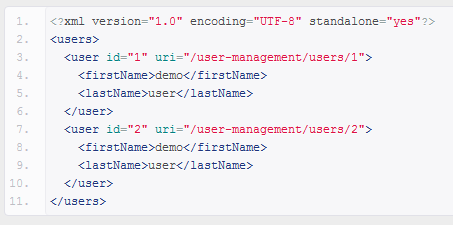RESTEasy + JBOSS 7 Hello world application---reference
RESTEasy is JBOSS provided implementation of JAX-RS specification for building RESTful Web Services and RESTful Java applications. Though this is not limited to be used in JBOSS only, and you can use with other servers also. In this post, I am building such a hello world application in JBOSS AS7 server.
Environment used:
- RESTEasy 2.3.1.GA
- Jboss AS7
- JDK 1.6
Follow below steps to build a demo application.
1) Create a maven project and convert to eclipse web project
mvn archetype:generate -DgroupId=com.howtodoinjava -DartifactId=RESTfulDemoApplication
-DarchetypeArtifactId=maven-archetype-webapp -DinteractiveMode=false mvn eclipse:eclipse -Dwtpversion=2.0
2) Update runtime dependencies in pom.xml
You need to define only compile time dependencies. Even better, if you can identify and include the jars from jboss distribution package.
|
1
2
3
4
5
6
7
8
9
10
11
12
13
14
15
16
17
18
19
20
21
22
23
24
25
26
27
28
29
30
31
32
33
34
35
36
37
38
39
40
41
42
43
44
45
46
47
48
49
50
51
52
53
54
|
<project xmlns="http://maven.apache.org/POM/4.0.0" xmlns:xsi="http://www.w3.org/2001/XMLSchema-instance" <modelVersion>4.0.0</modelVersion> <groupId>com.howtodoinjava</groupId> <artifactId>RESTfulDemoApplication</artifactId> <packaging>war</packaging> <version>1.0-SNAPSHOT</version> <name>RESTfulDemoApplication Maven Webapp</name> <repositories> <repository> <id>jboss</id> </repository> </repositories> <dependencies> <dependency> <groupId>junit</groupId> <artifactId>junit</artifactId> <version>3.8.1</version> <scope>test</scope> </dependency> <!-- core library --> <dependency> <groupId>org.jboss.resteasy</groupId> <artifactId>resteasy-jaxrs</artifactId> <version>2.3.1.GA</version> <scope>compile</scope> </dependency> <!-- JAXB support --> <dependency> <groupId>org.jboss.resteasy</groupId> <artifactId>resteasy-jaxb-provider</artifactId> <version>2.3.1.GA</version> <scope>compile</scope> </dependency> <!-- multipart/form-data and multipart/mixed support --> <dependency> <groupId>org.jboss.resteasy</groupId> <artifactId>resteasy-multipart-provider</artifactId> <version>2.3.1.GA</version> <scope>compile</scope> </dependency> <dependency> <groupId>net.sf.scannotation</groupId> <artifactId>scannotation</artifactId> <version>1.0.2</version> <scope>compile</scope> </dependency> </dependencies> <build> <finalName>RESTfulDemoApplication</finalName> </build></project> |
3) Create a blank web.xml file
JBOSS’s inbuilt support RESTeasy makes it a perfect combo for RESTFul web application. The minimum configuration to build such application is none. Yes, a blank web.xml file.
|
1
2
3
4
5
6
7
|
<!DOCTYPE web-app PUBLIC "-//Sun Microsystems, Inc.//DTD Web Application 2.3//EN"<web-app> <display-name>Restful Web Application</display-name></web-app> |
5) Register the application path
You will need to extend javax.ws.rs.core.Application class and provide @ApplicationPath annotation.
|
1
2
3
4
5
6
7
8
9
10
11
12
13
14
15
16
17
18
|
<img src="http://howtodoinjava.com/wp-content/uploads/jboss+resteasy1.png" alt="JBOSS 7+ RESTEasy demo application" width="453" height="225" class="size-full wp-image-2033" /> JBOSS 7+ RESTEasy demo applicationpackage com.howtodoinjava;import java.util.Arrays;import java.util.HashSet;import java.util.Set;import javax.ws.rs.ApplicationPath;import javax.ws.rs.core.Application;import com.howtodoinjava.service.UserService;@ApplicationPath("/")public class ApplicationConfig extends Application { @SuppressWarnings("unchecked") public Set<Class<?>> getClasses() { return new HashSet<Class<?>>(Arrays.asList(UserService.class)); }} |
4) Write a service class having @Path annotations
|
1
2
3
4
5
6
7
8
9
10
11
12
13
14
15
16
17
18
19
20
21
22
23
24
25
26
27
28
29
30
31
32
33
34
35
36
37
38
39
40
41
42
43
44
45
46
47
48
49
50
51
52
53
54
55
56
57
58
59
60
61
62
63
64
65
66
67
68
69
70
71
72
73
74
75
76
77
78
79
80
81
82
83
84
85
86
87
88
89
90
91
92
93
94
95
96
97
98
99
100
101
102
103
104
105
106
107
108
109
110
111
112
113
114
115
116
117
118
119
120
121
122
123
124
125
|
package com.howtodoinjava.service;import java.net.URI;import java.net.URISyntaxException;import java.util.ArrayList;import javax.ws.rs.Consumes;import javax.ws.rs.DELETE;import javax.ws.rs.DefaultValue;import javax.ws.rs.GET;import javax.ws.rs.POST;import javax.ws.rs.PUT;import javax.ws.rs.Path;import javax.ws.rs.PathParam;import javax.ws.rs.Produces;import javax.ws.rs.QueryParam;import javax.ws.rs.core.Response;import javax.xml.bind.annotation.XmlAccessType;import javax.xml.bind.annotation.XmlAccessorType;import javax.xml.bind.annotation.XmlElement;import javax.xml.bind.annotation.XmlRootElement;import com.howtodoinjava.model.User;import com.howtodoinjava.model.Users;@XmlAccessorType(XmlAccessType.NONE)@XmlRootElement(name = "user-management")@Path("/user-management")public class UserService { @XmlElement(name = "users") private String uri1 = "/user-management/users"; @XmlElement(name = "report") private String uri2 = "/user-managemet/generate-report"; public String getUri1() { return uri1; } public void setUri1(String uri1) { this.uri1 = uri1; } public String getUri2() { return uri2; } public void setUri2(String uri2) { this.uri2 = uri2; } @GET @Path("/") @Produces("application/vnd.com.demo.user-management+xml;charset=UTF-8;version=1") public UserService getServiceInfo() { return new UserService(); } @GET @Path("/users") @Produces("application/vnd.com.demo.user-management.users+xml;charset=UTF-8;version=1") public Users getAllUsers() { User user1 = new User(); user1.setId(1); user1.setFirstName("demo"); user1.setLastName("user"); user1.setUri("/user-management/users/1"); User user2 = new User(); user2.setId(2); user2.setFirstName("demo"); user2.setLastName("user"); user2.setUri("/user-management/users/2"); Users users = new Users(); users.setUsers(new ArrayList<User>()); users.getUsers().add(user1); users.getUsers().add(user2); return users; } @GET @Path("/users/{id}") @Produces("application/vnd.com.demo.user-management.user+xml;charset=UTF-8;version=1") public User getUserById(@PathParam("id") int id) { User user = new User(); user.setId(id); user.setFirstName("demo"); user.setLastName("user"); user.setUri("/user-management/users/" + id); return user; } @POST @Path("/users") @Consumes("application/vnd.com.demo.user-management.user+xml;charset=UTF-8;version=1") public Response createUser(User user, @DefaultValue("false") @QueryParam("allow-admin") boolean allowAdmin) throws URISyntaxException { System.out.println(user.getFirstName()); System.out.println(user.getLastName()); return Response.status(201) .contentLocation(new URI("/user-management/users/123")).build(); } @PUT // @Path("/users/{id: [0-9]*}") @Path("/users/{id}") @Consumes("application/vnd.com.demo.user-management.user+xml;charset=UTF-8;version=1") @Produces("application/vnd.com.demo.user-management.user+xml;charset=UTF-8;version=1") public User updateUser(@PathParam("id") int id, User user) throws URISyntaxException { user.setId(id); user.setFirstName(user.getFirstName() + "updated"); return user; } @DELETE @Path("/users/{id}") public Response deleteUser(@PathParam("id") int id) throws URISyntaxException { return Response.status(200).build(); }} |
5) Run the application
When we deploy above built application in jboss and hit the URL: ” http://localhost:8080/RESTfulDemoApplication/user-management/users”, below is the response.

reference from:http://howtodoinjava.com/2013/05/12/resteasy-jboss-7-hello-world-application/
RESTEasy + JBOSS 7 Hello world application---reference的更多相关文章
- Hibernate Validator 6.0.9.Final - JSR 380 Reference Implementation: Reference Guide
Preface Validating data is a common task that occurs throughout all application layers, from the pre ...
- 转载---jboss简单使用
初学Jboss,对于Jboss的基础认识以及配置做一些记录 Jboss基础: JBoss是什么–基于J2EE的应用服务器–开放源代码–JBoss核心服务不包括支持servlet/JSP的WEB容器,一 ...
- Jboss基础及简单的应用
初学Jboss,对于Jboss的基础认识以及配置做一些记录 Jboss基础: JBoss是什么–基于J2EE的应用服务器–开放源代码–JBoss核心服务不包括支持servlet/JSP的WEB容器,一 ...
- jboss相关的术语
1 jboss eap java ee application server.red hat官方版本. 2 jboss as/wildfly java ee application server的社区 ...
- zt 比较各JAX-RS实现:CXF,Jersey,RESTEasy,Restlet
http://news.misuland.com/20080926/1222396399411.html JavaSE/EE执行委员批准了JSR 311 JAX-RS作为支持RESTful web服务 ...
- 分布式服务治理框架Dubbo的前世今生及应用实战
Dubbo的出现背景 Dubbo从开源到现在,已经出现了接近10年时间,在国内各大企业被广泛应用. 它到底有什么魔力值得大家去追捧呢?本篇文章给大家做一个详细的说明. 大规模服务化对于服务治理的要求 ...
- RESTful和JAX-RS
一.简介 Java Web有很多成熟的框架,主要可以分为两类Web Application和Web Services.用于Web Application的框架包括官方的Servlet/JSP, JST ...
- Apache CXF 102 CXF with REST
前言 续上篇Apache CXF 101,摘抄部分REST概念性知识,以运行实例考察CXF对REST的支持. 目录 1 REST简介 2 工具 3 运行实例 内容 本Spike记录中内容,如无特别指出 ...
- WebService基础学习(二)—三要素
一.Java中WebService规范 JAVA 中共有三种WebService 规范,分别是JAX-WS.JAX-RS.JAXM&SAAJ(废弃). 1.JAX-WS规范 ...
随机推荐
- js创建对象的三种方法:文本标识法和构造器函数法和返回对象的函数
文本标识法和定义变量差不多,像这样 var obj = {name:'HanMM','2':'Dali'}; 函数构造器法 先创建一个对象函数 function Obj() { this.addre ...
- Oracle通过主键id删除记录很慢
问题描述: Oracle通过主键id删除2000条记录很慢,需要花费十二分钟. 解决过程: 1.首先查看SQL的执行计划,执行计划正常,cost只有4,用到了主键索引. 2.查看等待事件, selec ...
- java 全角、半角字符串转换
转自:http://www.cnblogs.com/modou/articles/2679815.html 加入了空字符串的验证 半角转全角的方法: /** * @Title: ToSBC * ...
- 功能: 用函数 funName 对数组 objArray 中的每个值进行处理一次,
function each( objArray, funName ) {//功能: 用函数 funName 对数组 objArray 中的每个值进行处理一次,for(var i=0; i<obj ...
- 【转】HTML5 LocalStorage 本地存储
原文见:http://www.cnblogs.com/xiaowei0705/archive/2011/04/19/2021372.html 说到本地存储,这玩意真是历尽千辛万苦才走到HTML5这一步 ...
- python自动开发之第十三天
1.Paramiko模块下的demo.py程序 前面利用Python中的Paramiko模块可以进行SSH的连接,以及用来传送文件(SFTP),但是无论是哪一种方式,连接都是短暂的,并非是长连 ...
- java导入导出excel常用操作小结及简单示例
POI中常用设置EXCEL的操作小结: 操作excel如下 HSSFWorkbook wb = new HSSFWorkbook(); //创建一个webbook,对应一个Excel文件 HSSFS ...
- Zabbix的LLD功能--Low-level discovery
感觉这个主题是和一个主题是一个系列,而且更基础. 准备深入研究一下... 相关文档准备: https://www.zabbix.com/documentation/2.0/manual/discove ...
- 【数学相关、规律】Codeforces 696B Puzzles
题目链接: http://codeforces.com/problemset/problem/696/B 题目大意: 给一棵树,从根节点开始递归,time=1,每次递归等概率随机访问这个节点的子节点, ...
- linux运维社区站点收集
1, 新世纪linux社区 offical locator: http://www.21ops.com/industry-news/24370.html 2,
